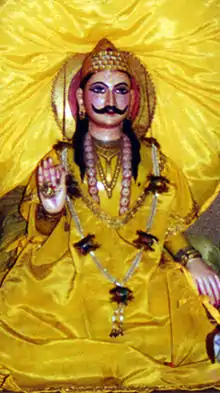
Sant Charandas was a major Hindu religious teacher in Delhi during the eighteenth century.[1]
Biography
Sant Charandas was born in the village Dehra in the Alwar District, Rajasthan in Vikrami Samvat 1760 i.e. 1703 AD in Chyavan Gautriya Bhriguvanshi Dhusar Brahmin family. His father Murlidhar Das and mother Kunjo Devi were devotees of Lord Krishna. Sant Charandas is believed to be an anshavatar (partial reincarnation) of Lord Krishna.
At the age of five, Shri Shukdev Muni visited and gave him DARSHAN. In adolescence, he left for pilgrimage and at the age of 19 years, Shri Shukdev Muni appeared before him and provided GURU DEEKSHA at SHUKTAL on the bank of GANGAJI. After his DEEKSHA Sant Charandas lived in Delhi and performed 14 years of penance. Later he visited Shri Vrindavan Dham and returned back to Delhi after Lord Krishna appeared before him in Vrindavan and ordered him to spread BHAKTI among the masses.
As word spread of his influence and miracles in Delhi, the then King Muhammadshah of Delhi became his disciple and donated him many villages. Sant Charandas had predicted of an attack on Delhi by King Nadirshah of Iran six months earlier as a prophecy in writing to King Muhammadshah. King Nadirshah was also a witness to his miracles.
SANT CHARANDAS has written following 17 books on Yoga, Bhakti and Sant Darshan :
1. BRIJ CHARITRA ब्रजचरित्र 2. AMARLOK AKHAND DHAM VARNAN अमरलोक अखण्डधाम वर्णन 3. ASHTANGA YOG अष्टाङ्गयोग 4. SHATKARM HATHYOG VARNAN षट्कर्म हठयोग वर्णन 5. YOG SANDEH SAGAR योगसन्देश सागर 6. GYAN SWARODAYA ज्ञानस्वरोदय 7. HAMSNADOPNISHAD हंसोपनिषद 8. DHARAM JAHAJ धर्मजहाज 9. SARVOPNISHAD सर्वोपनिषद 10. TATVA YOGOPNISHAD तत्वयोगोपनिषद 11. YOGSHIKHOPNISHAD योगशिखोपनिषद 12. TEJBINDU UPNISHAD तेजबिन्दु उपनिषद 13. BHAKTI PADARATH भक्ति पदार्थ 14. MANVIKRIT KARAN GUTKASAR मनविकृत करण गुटकासार 15. SHRIBRAHMGYANSAR श्रीब्रह्मज्ञानसार 16. SHABDVARNAN शब्द वर्णन 17. BHAKTISAGAR VARNAN भक्तिसागर वर्णन.
He was succeeded to his spiritual seat (Guru-Gaddi) by the cousin sisters of his Chyavan Gautriya Bhriguvanshi Dhusar family of Alwar: the Saints Sahjo Bai and Daya Bai were the nieces and disciples of Sant Charandas. Both the women saints' verses were read and liked widespread all over India from Delhi to Gujarat. There are more than a hundred monasteries in the whole of India of SHUK SECT of Vaishnavas established by Sant Charan Das.
SANT CHARANDAS achieved salvation by sacrificing body by Samadhi in Vikrami Samvat 1839 i.e. 1782 AD at the age of 79.
Teachings
Charandas is the author of around twenty works.[2] Many of these are in verse and deal with aspects of devotion, particularly relating to the worship of Krishna.[3] He is credited by his followers with a vision of Krishna while on pilgrimage to Vraj in mid-life, as well as a further meeting with Shukdev at the same time.[1]
He wrote commentaries on various Upanishads, particularly the Katha Upanishad,[3] and on specific yoga practices, especially Pranayama, control of the breath.[4]
A member of the Sant mystical tradition,[5] Charandas's teachings draw on a wide range of sources and emphasize the nearness of the Divine to each person, the need to follow a guru, the importance of sharing in a community of like-minded believers not dependent on caste (Satsang), and the value of leading a strictly moral life.
Two of his major disciples, Sahjo Bai and Daya Bai, both women, are also famous for their poetry.[6][7][8]
Sources
- 1 2 Gold, D. (1987). The Lord as Guru: Hini Sants in the Northern Indian Tradition. New York: Oxford University Press.
- ↑ Sukla, S (1995). Charandasia Sampraday aur uska Sahitya. Varanasi: Kali Prakasan. pp. 132–161.
- 1 2 Charandas (2001), Bhaktisagar, Mumbai: Khemraj Srikrishnadas Prakashan
- ↑ Charandas, Astangayogavarnan [Astanga Yoga of Saint Charandas], Translated Om Prakash Tiwari (1983), Lonavla: Kaivalyadham Press
- ↑ Schomer, K; McLeod, W (1987). The Sants. Delhi: Motilal Banarsidass.
- ↑ Bai, Sahjo (2001) [1903]. Sahaj Prakash. Translated by Harry Aveling; Sudha Joshi. Delhi: Motilal Banarsidass. Allahabad: Belvedere Press.
- ↑ Bai, Daya (2005) [1908], Daya Bai ki Bani [The Songs of Daya Bai], translated by Harry Aveling; Peter Friedlander, Delhi: Prestige Books, Allahabada, Delhi: Belvedere Press
- ↑ McGregor, R.S. (1984). Hindi Literature of the nineteenth and early twentieth centuries (Vol. 8 Part 1). Verlag: Otto Harrassowitz.
References
- Charandas (2014), Bhaktipadarth [The Treasury of Devotion], translated by Peter Friedlander; Harry Aveling, Delhi: Prestige Books
- Osho Rajneesh (1978), Nahin Sanjh Nahin Bhor, Pune: Rajneesh Foundation
- Sahjo Bai (2001), Sahaj Prakash [The Brightness of Simplicity], translated by Harry Aveling; Sudha Joshi, Delhi: Motilal Banarsidass, Allahabad: Belvedere Press